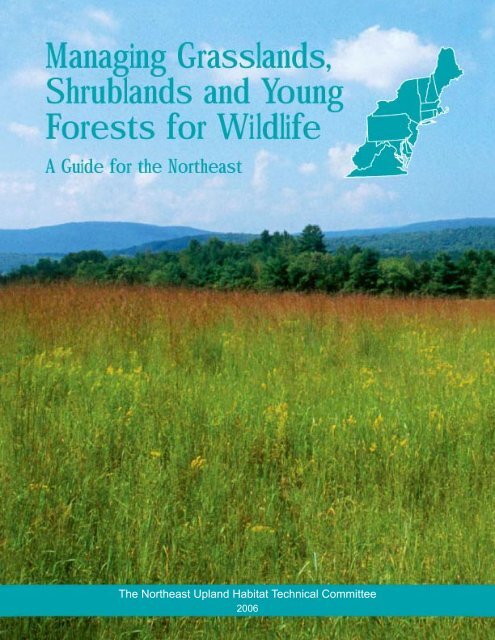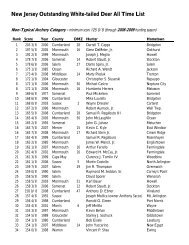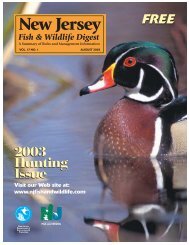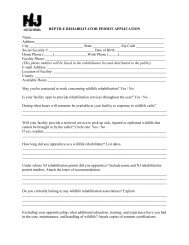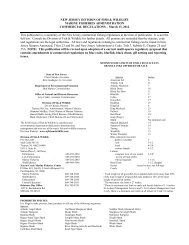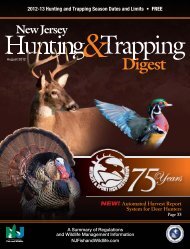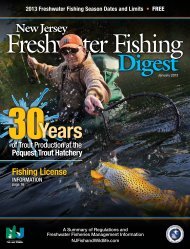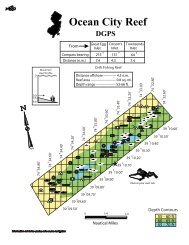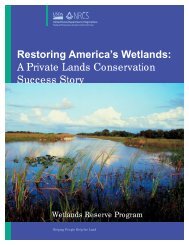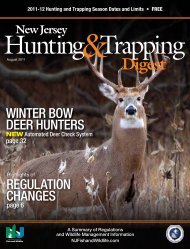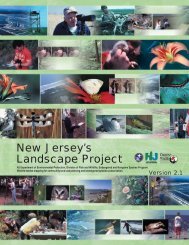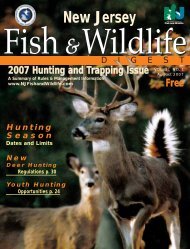Contents - Avalonia Land Conservancy
Contents - Avalonia Land Conservancy
Contents - Avalonia Land Conservancy
- No tags were found...
Create successful ePaper yourself
Turn your PDF publications into a flip-book with our unique Google optimized e-Paper software.
The Northeast Upland Habitat Technical Committee2006
Managing Grasslands,Shrublands, andYoung Forest Habitats forWildlifeA Guide for the NortheastEdited by:James D. OehlerNew Hampshire Fish & Game DepartmentDarrel F. CovellUniversity of New Hampshire Cooperative ExtensionSteve CapelVirginia Department of Game & Inland FisheriesBob LongMaryland Department of Natural ResourcesPublished by:The Northeast Upland Habitat Technical CommitteeMassachusetts Division of Fisheries & Wildlife2006ii
PrefaceOn the weekend of May 4 - 5, 2002, over 200 ecologists, forest managers, and private landowners fromacross the Northeast descended onto the campus of the University of New Hampshire to attend a conferencethat focused on the importance, status, and management of shrublands and young forest habitats in the region.My participation in this conference both as a presenter and audience member led to the realization that toeffectively remediate the negative impacts of the decline of these habitats on wildlife more needed to be doneto educate land managers and private landowners about their importance and how to manage them. Relativelylittle has been done in this regard. It is my hope that this guide will help to fill this void to some extent. Giventhat more than 73% of forestland in the region is privately owned, it is imperative that landowners and theprofessionals that provide resource management guidance help to address the decline of these habitats. Theactive participation of landowners and land managers in addressing this issue is the only way to ensure enoughof these habitats will be available for the multitude of species dependent on them well into the future.— James D. Oehler (June 30, 2004)AcknowledgementsThis guide is a publication of the Northeast Upland Habitat Technical Committee, sanctioned by theNortheast Association of Fish and Wildlife Directors. The Northeast Upland Habitat Technical Committeeis comprised primarily of state wildlife agency biologists who specialize in upland habitat management. Thecommittee was formed in 1998 by the Northeast (State) Wildlife Administrators Association to address thedecline of grassland, shrubland, and young forest habitats in the region, and to develop recommendations andguidance to the administrators on the 2002 Farm Bill. Members of the committee as of June 2004 are:Paul Rothbart (Chairman), Connecticut Department of Environmental ProtectionCharles Bridges, New Hampshire Fish & Game DepartmentAndrew Burnett, New Jersey Division of Fish, Game & WildlifeSteve Capel, Virginia Department of Game & Inland FisheriesDarrel F. Covell, University of New Hampshire Cooperative ExtensionScott Darling, Vermont Fish & Wildlife DepartmentRichard Dressler, Maine Department of Inland Fisheries & WildlifeGary M. Foster, West Virginia Division of Natural ResourcesJean Gawalt, New York Department of ConservationRon Helinski, Wildlife Management InstituteScott Klinger, Pennsylvania Game CommissionJohn W. Lanier, New Hampshire Fish & Game DepartmentBob Long, Maryland Department of Natural ResourcesJonathan McKnight, Maryland Department of Natural ResourcesGreg Moore, Delaware Division of Fish and WildlifeJohn Moulis, Maryland Department of Natural ResourcesJames D. Oehler, New Hampshire Fish & Game DepartmentPaul O’Neil, U.S. Fish & Wildlife ServiceTim Post, New York Division of Environmental ConservationJohn J. Scanlon, Massachusetts Division of Fish & WildlifeBrian C. Tefft, Rhode Island Division of Fish & WildlifeJudy M. Wilson, Connecticut Department of Environmental ProtectionBill Whitman, Delaware Division of Fish & WildlifeScot Williamson, Wildlife Management InstituteCommittee members acted as authors, reviewers, and/or supporters of the guide. I thank all members,past and present, for their efforts in helping to make this guide a reality. I would also like to thank all ofthe other authors that contributed to this guide who are not committee members. They graciously offeredtheir expertise to help make this guide more complete. Thanks also go out to the talented individuals in theiii
Information and Education Section of the Massachusetts Division of Fisheries & Wildlife for providing theirexpertise in completing the formatting and layout of the guide. Robin Blum of the Connecticut Department ofEnvironmental Protection offered her time and skill for copy editing.The quality of this publication was substantially enhanced by the time and expertise provided by a talentedpool of peer reviewers. In addition to committee members, peer reviewers included Robert Askins, MarkBanker, Joel Carlson, Alan Carter, Steve Clubine, Tim Cooper, Richard DeGraaf, Joseph Dowhan, CatherineHibbard, Andrea Jones, Ron Joseph, Paul Karczmarczyk, Gary Kemp, David Kittredge, Hal Laskowski, JohnLitvaitis, Chris Mattrick, Chris Miller, Laura Mitchell, William Murphy, Holly Obrecht, William Patterson,John Randall, Charles Rewa, Ellen Snyder, Janath Taylor, and Mariko Yamasaki. Thanks to all of them fortheir considerable help.ForewordThe wave of forest clearing that swept across the Northeast and Midwest beginning about 1750 is wellknown. <strong>Land</strong> that was cleared for agriculture was soon abandoned with the opening of the Erie Canal, theCalifornia Gold Rush, the Civil War, and the rise of industrial cities. Such clearing put a cultural premium onforests; they were rare compared to the open countryside, even though it was already reverting to forest withthe decline of agriculture in the first half of the 19 th century. Less well known is the extent and variety of earlysuccessional habitats that existed in much of the Northeast upon European settlement. Disturbances due to fire,hurricanes, floods, Native American burning and agriculture, and beaver, as well as native prairies, barrens,and oak openings imparted an open character to much of southern New England and the Mid-Atlantic region,and created patches of early successional and young forest habitats elsewhere. Such areas were tilled or grazedfrom earliest settlement; the loss of natural open habitats, once considerable, actually began centuries ago, andis now the most important wildlife habitat issue in the Northeast.Today, once open habitats have either reverted to forest or are developed, fire is controlled, and periodicflooding prevented to the fullest extent possible. Except for wind, creation of early successional habitats bynatural disturbance has been greatly curtailed for the past century or more, and wildlife populations dependentupon them have been quietly declining as well. Many of these species are habitat specialists, using onlyspecific-stages of old fields, or brushlands, or regenerating forests. Now in critically short supply such habitatsneed to be maintained by periodic treatment or created in places where they did not exist historically.This volume is a much-needed presentation of the specific management practices that are necessary tocreate or maintain early successional and young forest habitats on the northeastern landscape. In some casesthey replicate the processes that historically created them, fire, or past agriculture practices such as mowingor grazing. Newer methods such as use of herbicides and new problems such as invasive exotic plants furtherchallenge efforts to provide habitat for disturbance-dependent species.With most of the landscape in forest cover, great opportunities exist to provide young forest habitatthrough timber management. Even-aged silviculture is well suited both ecologically and economically tomost of the major forest types of the Northeast. Convincing the public and more landowners to use even-agedpractices or larger group/patch selection practices, however, will not be easy. Most suburban residents andeven some biologists view forestry activities not as periodic management of renewable resources, but rather asprecursors to development. Today’s wildlife agencies face the challenge of not only creating and maintainingdiverse wildlife habitats in forest landscapes across myriad landownership classes in the Northeast, but of alsoeducating the public in the overall values of such management for a wide variety of species. People need tounderstand that early-successional forest habitats are ephemeral by nature, and not permanent features on thelandscape. Active forest management can create the vegetative conditions many early-successional speciesas well as humans use, and can influence the proportion and distribution of early-successional habitats overtime. When practiced across essentially forested landscapes, a broad array of wildlife habitat values canbe enhanced as well as conserved without sacrificing mature forest values. Taken in total, this guide givesmanagers and interested publics some excellent insights into the nature of this management challenge and theiv
numerous opportunities to positively influence the presence and maintenance of early-successional habitats inthe Northeast now and in the future.— Richard M. DeGraaf and Mariko Yamasaki<strong>Contents</strong>PrefaceAcknowledgementsForeword – Richard M. DeGraaf, U.S. Forest Service, Northeastern Research StationMariko Yamasaki, U.S. Forest Service, Northeastern Research StationChapter 1. Introduction 1Darrel F. Covell, University of New Hampshire Cooperative ExtensionChapter 2. Looking Beyond Property Boundaries – <strong>Land</strong>scape and Regional Considerations for 7Managing Early-Successional HabitatsJohn Litvaitis, University of New HampshireChapter 3. Maintaining and Restoring Grasslands 14Paul Rothbart, Connecticut Department of Environmental ProtectionSteve Capel, Virginia Department of Game & Inland FisheriesChapter 4. Managing Shrublands and Old Fields 28Brian C. Tefft, Rhode Island Division of Fish & WildlifeChapter 5. Managing Regenerating and Young Forest Habitat 35John W. Lanier, New Hampshire Fish & Game DepartmentChapter 6. Managing Small Forest Openings 43Judy M. Wilson, Connecticut Department of Environmental ProtectionChapter 7. Managing Abandoned Orchards and Apple Trees 51Judy M. Wilson, Connecticut Department of Environmental ProtectionChapter 8. Invasive Exotic Plants in Early-Successional Habitats 58James D. Oehler, New Hampshire Fish & Game DepartmentChapter 9. Riparian Zones: Managing Early-Successional Habitats Near the Water’s Edge 69Thomas P. Hodgman, Maine Department of Inland Fisheries & WildlifeChapter 10. Habitat Management Toolsa. Using Prescribed Fire to Manage Habitats in the Northeast 79Tim Simmons, Massachusetts Natural Heritage & Endangered Species Programb. Herbiciding 87James D. Oehler, New Hampshire Fish & Game Departmentc. Grazing for Wildlife Habitat Enhancement 95Tyler Webb, Vermont Natural Resources conservation Serviced. Mechanical Tools 99Steve Hill, U.S. Fish & Wildlife Service
Chapter 11. Habitat Management Case Studiesa. Creating Early-Successional Habitat on a Small Woodlot in Southeastern New Hampshire 105Matt Tarr, University of New Hampshire Cooperative Extensionb. Grouse Management at the Monongahela National Forest, West Virginia 110Gary M. Foster, West Virginia Division of Natural Resourcesc. Massachusetts Woodlands Cooperative: A New Tool for <strong>Land</strong>scape Planningand Management 115Paul Cantanzaro, University of Massachusettsd. Quail and Cottontail Management on Buck Range Farm, Maryland 123Bob Long, Maryland Department of Natural ResourcesDonald Webster, Maryland Department of Natural Resourcese. Case Study: Pennsylvania’s Conservation Reserve Enhancement Program 129Colleen A. DeLong, Pennsylvania Natural Resources Conservation ServiceJeffery D. Finn, Pennsylvania Natural Resources Conservation ServiceChapter 12. Opportunities to Obtain Financial Assistance for Wildlife Habitat Management Projects 136James D. Oehler, New Hampshire Fish & Game DepartmentAppendix A Contact Information for Selected Federal and State Agencies 140Appendix B List of Common and Scientific Names of the Plant and Animal SpeciesMentioned in This Guide 143vi


